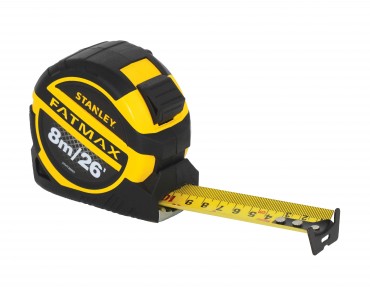
John Bleasby
Canada’s march to metric is measured in inches and centimetres
Canadian ContractorA random mixture of metric and imperial measures has made us a bilingual nation
Brian Mulroney drove a stake through the heart of Canada’s headlong conversion to the metric system in 1984 when his government abolished the Metric Commission. Thus ended the previous Liberal government’s determination to ram metric down the throats of Canadians. Given the wide-spread resistance to conversion to metric, the Conservative government wisely laid the issue to rest by simply backing off.
Since then, many regulations forcing metric conversion on Canadians have been either repealed or just plain ignored. And while there is no talk of the newly-elected Liberals sending jack-booted metric police to knock down doors in the near future, the government still promotes conversion to metric in areas where it stalled halfway, like Canada’s construction and home-building industry, using helpful on-line conversion tips and tables.

Paint cans in litres, brushes in inches!
Letting the marketplace decide
Our industry currently operates with a laissé-faire acknowledgement of metric, with a whole lot of imperial thrown in. For example, most commercial plans, certainly anything governmental, are drawn in metric measures. Residential drawings? Not so much. The result is not as confusing as it is time consuming doing conversions back and forth.
“Realistically you have to speak both languages” explains Tom Johnston, outside sales representative for RONA in Barrie Ontario. “This is especially true in the engineering when you go into Part 9 of the building code. For example when you’re looking up the span of a 2 x 6 on 16 inch centers, the code tells you how much it is in meters, so you’ve got to work it all back.”
Construction industry veterans like Johnson have it a bit easier than the younger generation who learned metric in school. The imperial system is quite foreign to them, forcing them to adapt. “Younger people coming into the business are learning how to go back and forth; it’s coming along slowly” explains Johnston. “It depends on who trains them. If they’re working under an older guy, they’re probably speaking in both systems.”
Who rules? Metric or Imperial?
Interestingly, when it comes to fluid measures, like auto gas purchases, Canada has been quicker to adopt metric. This makes for some interesting scenarios in the building supply store however, when customers happily seek out paint in litres and brushes in inches.
For the tool industry, the evolution to metric has been slow. Although you will continue to see a 6 inch radial saw on display, you aren’t likely to see it labelled as a 15.24cm radial saw any time soon. “We sell both the SAE and the metric” says Johnston, “but after that initial push, it kind of died. There was no pressure to go any further with it.”

Stanley’s most popular tape measure in the ‘bilingual’ version
Tale of the tape
In terms of pure measurement itself, bilingualism is more evident. “In the past few years, we have seen the balance start to even and then tip toward English/Metric tape rules (vs. straight imperial measure) in our ProTape categories” says Louise Fair, Commercialization Manager for Hand Tools and Storage in Canada for Stanley Black & Decker. Which makes perfect sense; today’s education base favours the metric system, and therefore metric is more applicable for graduates of college and apprenticeship skill courses. “Specifically, we now ship more FatMax 26’/8m tapes than straight 25′ ” Fair continues. “In the past few years we launched a straight metric line of FatMax tapes (5m, 8m, etc.). Although the adoption was initially slow we have seen consistent growth in demand for metric only.”
Only in Canada, eh?
This, of course, will never prevent Canadians from being creative in their day-to-day use of measurements. For example when asked where I live, I will say “5 minutes from a small village about 40 minutes north of Barrie.” In fact, time is a more common measure for distances between points in Canada than either the metric or imperial systems. When asked how far it is from Edmonton to Fort McMurray, the answer is “about five hours.” That simplifies everything!
follow John on Twitter 
@john_bleasby
Advertisement
Print this page

Dear Mr. Bleasby,
Thank you for your summary regarding the subject of metrication in Canada. While you describe quite well the chain of events that took place that helped derail this process in Canada I must respectfully (but) wholeheartedly disagree with you calling it ‘wise’! There is *nothing* wise in stalling progress, sir!
Perhaps you may not know that the SI system can clearly be demonstrated to be a *far superior* *true system* compared to this hodge-podge of incoherent, inconsistent, medieval collection of units one calls “imperial system of units”. There is no question that there is near *unanimous* agreement amongst the most reputable experts in metrology (including scientists, and business people *from the US*!) that the SI system should be THE system of units used by humanity. The testimony of over 95% of the world’s population who use it on a daily basis is strong enough evidence of such superiority.
The ONLY reason one may conclude that it would be ‘wise’ to let ‘the marketplace’ decide (for instance) whether or not one should adopt it fully is sheer convenience and people’s natural aversion to change. There is plenty of evidence that where metrication is NOT introduced with legislation that has teeth in it people end up being *way* worse off.
For instance, in the construction industry I was able to make a quick estimate in regards to efficiencies related to the simple USE of one versus the other and concluded that it costs Canada over 4 BILLION dollars a year to continue using feet and inches! Plus the intangible costs associated with uncountable number of errors which are *very* common place when people have to do simple calculations using fractions and unnecessary conversions between feet and inches. In MY OWN house in Alberta I could see those errors which for untrained eyes would go unnoticed to the tune of an excess of whopping 2 centimetres in several places (doors that are unleveled, height of frames taller on the left side by that much compared to the right side which is only about less than 90 cm apart from the left!!). And the builder of my home is reputed to be among the best in the business in Alberta!
I honestly do not understand why such attachment to something which NO TWO HISTORIANS agree exactly on how this thing was created in the first place (except to know that it was based on human dimensions of some obscure anglo-saxon king of the 10th century!).
Perhaps one of the major hurdles for this technology to take hold here (and in the US) may reside on people’s *false* thinking that it is a *cultural* thing when it obviously isn’t. BTW no one is advocating that we change clearly cultural *language expressions* like ‘going the whole 9 yards’, or ‘I wouldn’t touch that with a 10-foot pole’, or even ‘an ounce of prevention is worth a pound of cure’, etc.
Therefore, to conclude, I would rather see prestigious leaders of this industry, including yourself, sir, defend bringing our country into the 21st century and beyond, than to gloat about our perceived “advantage” of being able to muddle through a confused environment which leads nowhere, except an exercise in futility.
In the meantime, I will continue to humbly demonstrate to whoever I come in contact with that it pays to ‘go metric’ BIG time (like a contractor I asked to do my basement 15 years who came to his senses agreeing in the end how much better our project went when I insisted to have it done COMPLETELY in metric!), *in spite* of a ‘sea of imperialists’ in this industry all around us.
I can only hope and pray though that the day will come when we’ll resurrect the Metric Commission to finish the job which should have NOTHING TO DO with being ‘conservative or liberal’. The apparent high initial investment of doing so will WITH CERTAINTY save our country countless billions of dollars in the years ahead, as well as simplify the lives of all of us.
Respectfully,
Marcus Berger
BS Aer Eng, MS Eng*, PhD Eng*, MBA, CPA, CGA
Thanks for this well-researched article. I am currently tutoring a secondary school student who fell far behind in math in middle school. She is completely unfamiliar with Imperial measurements, so she is being graded this year on just metric units of measurement.
I was starting high school when the Metric Commission began implementing the metric system, so I can convert between both easily. How interesting to learn that it was the Conservative government of Brian Mulroney, a great “Yankee-lover” among Canada’s prime ministers, who abolished the Metric Commission long before its task was done.
Canadians still must be vigilant in grocery stores today, as the store managers often fail to reprogram the cash registers correctly when meat or fresh produce are advertised on sale for $ X.00 a pound. The customer often pays the non-sale price, as all the registers are programmed in metric units, charging the original price per kilogram instead of the comparable sale price in metric.
I recently bought 2 pounds of grapes (900 grams approx.) sold at $2.00 a pound. I paid $7.98 for my 2 pounds of grapes, instead of $4.00, because the register still had them coded at the old price of $8.80/kilogram. I pointed this out to the manager, who gave me a store credit for $3.98. But it was too bad for the many other customers who bought grapes for the original price when they thought they were getting them for about half-price. My calculator is my best friend while food shopping these days.
A great article. I have a math disability so working with metric truly is 100 times easier than dealing with fractions. I can use imperial but I have to triple check every measurement and calculation. I hope metric is the way of the future as it is clearly superior and far easier for everyone to understand and calculate.
I work day in and day out in the construction industry. The imperial system works just fine. We do not sell spaces by the square meter. We sell spaces by the square foot. Home owners ask us how many square feet the house it. They don’t ask how many square meters it is. We purchase lumber by the lineal foot. We buy and build with 2 x4’s. All of our proformas are based on the imperial system. Buildings codes and by-laws should show imperial units. If you want to show metric units, I have no problem with that. However, I do have a problem when you take away the imperial units. When a person is 6ft tall, we know what you are talking about. If you say they are 1.80m, we don’t know what you are taking about. This is Canadian culture. You will not be able to change it. I am currently building a 2500 square foot house. You know how big that is. You can visualize it. If I told you that I was building a 245 square meter house, I bet most educated Canadians would not be able to visualize it, engineering degree or no engineering degree. The forced metric system in the residential construction industry is a joke of bureaucratic proportions.
I do not think those that like metric know or understand what happened when the lumberyards tried to sell plywood and lumber with metric units. It didn’t last long because of the waste. All buildings have been built in North America for the last how many hundreds of years with the imperial measurements. Those government buildings with metric measurements started out in imperial and then metric measurements used to replace the imperial. So while I am now retired, I spent many years converting those government plans back to imperial to fit the supplies we would have to order to complete the renovation or the part of the new building we were responsible for. I believe metric works in some areas but in construction because the renovation industry is bigger than the new construction here in Canada we should quit the conversion game to save dollars and time and stay with Imperial. There are times when quoting a job plans start out in imperial then replaced with metric added, then converted back to imperial, then having to take certain materials needed which came in metric and converting it back to imperial to fit your quote. It’s a stupid game to keep the converted with metric happy but a waist of time and money. Let metric work where it works and Imperial works where it works. It’s easier to remember 20 feet than 609.6 centimeters or 18 inches on center than 45.72 centimeters on center which is what the construction industry is based on.
First of all… it’s centimetres not centimeters. We are Canadian not American. Generally speaking the population that rejects the metric system is aging and smaller in numbers. We are a metric country.